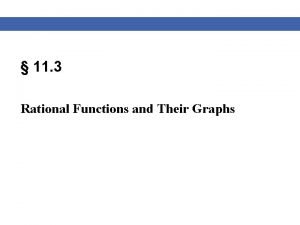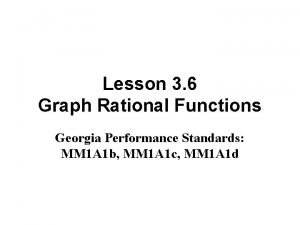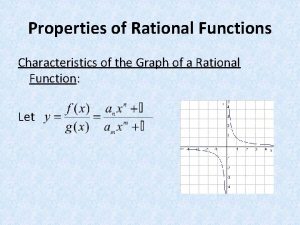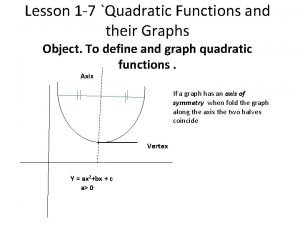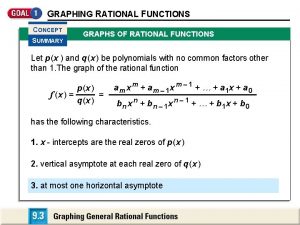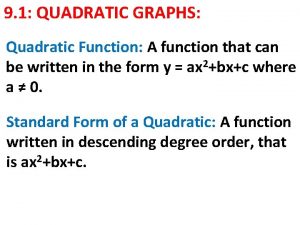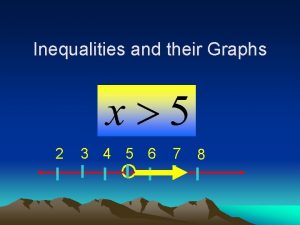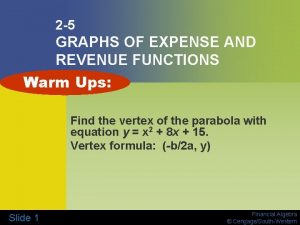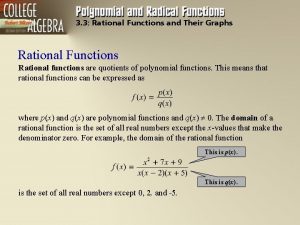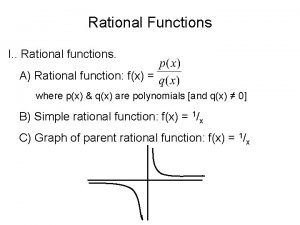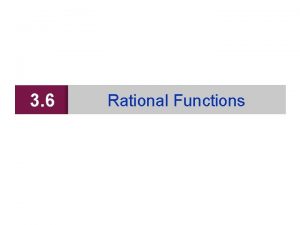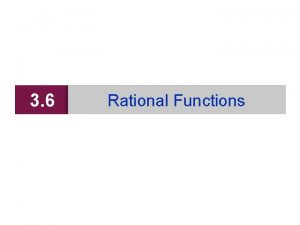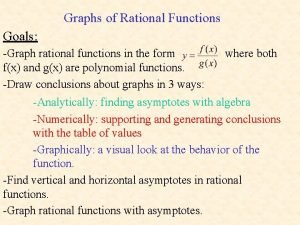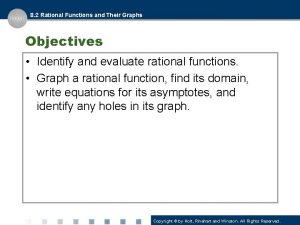8 3 RATIONAL FUNCTIONS AND THEIR GRAPHS SUMMARY
































- Slides: 32

8. 3 RATIONAL FUNCTIONS AND THEIR GRAPHS

SUMMARY OF HOW TO FIND ASYMPTOTES Vertical Asymptotes are the values that are NOT in the domain. To find them, set the denominator = 0 and solve. “WHAT VALUES CAN I NOT PUT IN THE DENOMINATOR? ? ” To determine horizontal or oblique asymptotes, compare the degrees of the numerator and denominator. 1. If the degree of the top < the bottom, horizontal asymptote along the x axis (y = 0) 2. If the degree of the top = bottom, horizontal asymptote at y = leading coefficient of top over leading coefficient of bottom 3. If the degree of the top > the bottom, oblique asymptote found by long division.

VERTICAL ASYMPTOTES Finding Asymptotes There will be a vertical asymptote at any “illegal” x value, so anywhere that would make the denominator = 0 So there are vertical asymptotes at x = 4 and x = -1. Let’s set the bottom = 0 and factor and solve to find where the vertical asymptote(s) should be.

HORIZONTAL ASYMPTOTES We compare the degrees of the polynomial in the numerator and the polynomial in the denominator to tell us about horizontal asymptotes. degree of top = 1 1 degree of bottom = 2 1<2 If the degree of the numerator is less than the degree of the denominator, (remember the x axis degree is a horizontal is the highest asymptote. power. This on any is along x term) the line x axis y =is 0. a horizontal asymptote.

HORIZONTAL ASYMPTOTES The leading coefficient is the number in front of the highest powered x term. degree of top = 2 1 degree of bottom = 2 horizontal asymptote at: If the degree of the numerator is equal to the degree of the denominator, then there is a horizontal asymptote at: y = leading coefficient of top leading coefficient of bottom

OBLIQUE ASYMPTOTES - Slanted degree of top = 3 If the degree of the numerator is greater than the degree of the denominator, then there is not a horizontal asymptote, but an oblique one. The equation is found by doing long division and the quotient is the equation of the oblique asymptote ignoring the remainder. degree of bottom = 2 Oblique asymptote at y = x +5

STRATEGY FOR GRAPHING A RATIONAL FUNCTION 1. Graph your asymptotes 2. Plot points to the left and right of each asymptote to see the curve

SKETCH THE GRAPH OF

The vertical asymptote is x = -2 The horizontal asymptote is y = 2/5


SKETCH THE GRAPH OF: Vertical asymptotes at? ? x=1 Horizontal asymptote at? ? y=0

SKETCH THE GRAPH OF: Vertical asymptotes at? ? x=0 Horizontal asymptote at? ? y=0

SKETCH THE GRAPH OF: Vertical asymptotes at? ? x=0 Horizontal asymptote at? ? y=0

SKETCH THE GRAPH OF: Hopefully you remember, y = 1/x graph and it’s asymptotes: Vertical asymptote: x = 0 Horizontal asymptote: y = 0 Vertical asymptotes at? ? Horizontal asymptote at? ? x=1 y=0

OR… We have the function: But what if we simplified this and combined like terms: Now looking at this: Vertical Asymptotes? ? x = -3 Horizontal asymptotes? ? y = -2

SKETCH THE GRAPH OF: Hole at? ? x=0

FIND THE ASYMPTOTES OF EACH FUNCTION: Vertical Asymptote: x=0 Slant Asymptote: y=x+3 Hole at x = 4 Vertical Asymptote: x = 0 and x = 7 Horizontal Asymptote: y=0

WHAT MAKES A FUNCTION CONTINUOUS? Continuous functions are predictable… 1) No breaks in the graph A limit must exist at every x-value or the graph will break. 2) No holes or jumps The function cannot have undefined points or vertical asymptotes.

CONTINUITY Key Point: Continuous functions can be drawn with a single, unbroken pencil stroke.

CONTINUITY OF POLYNOMIAL AND RATIONAL FUNCTIONS A polynomial function is continuous at every real number. A rational function is continuous at every real number in its domain.

DISCONTINUITY Discontinuity: a point at which a function is not continuous

DISCONTINUITY Two Types of Discontinuities 1) Removable (hole in the graph) 2) Non-removable (break or vertical asymptote) A discontinuity is called removable if a function can be made continuous by defining (or redefining) a point.

TWO TYPES OF DISCONTINUITIES

DISCONTINUITY Find the intervals on which these function are continuous. Point of discontinuity: Removable discontinuity Vertical Asymptote: Non-removable discontinuity

DISCONTINUITY Continuous on:

DISCONTINUITY Continuous on:

DISCONTINUITY Determine the value(s) of x at which the function is discontinuous. Describe the discontinuity as removable or non-removable. (A) (B) (C) (D)

DISCONTINUITY (A) Removable discontinuity Non-removable discontinuity

DISCONTINUITY (B) Removable discontinuity Non-removable discontinuity

DISCONTINUITY (C) Removable discontinuity Non-removable discontinuity

DISCONTINUITY (D) Removable discontinuity Non-removable discontinuity

CONCLUSION Continuous functions have no breaks, no holes, and no jumps. If you can evaluate any limit on the function using only the substitution method, then the function is continuous.
 Asymptote rules
Asymptote rules 8-3 practice rational functions and their graphs
8-3 practice rational functions and their graphs Sketch the graph of the following rational function
Sketch the graph of the following rational function Rational functions and their graphs
Rational functions and their graphs Lesson 3: rational functions and their graphs
Lesson 3: rational functions and their graphs What are the properties of rational functions
What are the properties of rational functions Polynomial function form
Polynomial function form Quadratic functions and their graphs
Quadratic functions and their graphs Chapter 1 functions and their graphs
Chapter 1 functions and their graphs Common functions and their graphs
Common functions and their graphs Polynomial vocabulary
Polynomial vocabulary Polynomial functions and their graphs
Polynomial functions and their graphs Analyzing graphs of polynomial functions calculator
Analyzing graphs of polynomial functions calculator Exponential functions and their graphs
Exponential functions and their graphs Chapter 2 functions and their graphs answers
Chapter 2 functions and their graphs answers Practice a investigating graphs of polynomial functions
Practice a investigating graphs of polynomial functions Investigating graphs of functions for their properties
Investigating graphs of functions for their properties State graph in software testing
State graph in software testing Graphs that enlighten and graphs that deceive
Graphs that enlighten and graphs that deceive Rational function summary
Rational function summary Speed and velocity
Speed and velocity Rational equation and rational inequalities
Rational equation and rational inequalities Rational graphs
Rational graphs Rational functions in medicine
Rational functions in medicine 9-1 quadratic graphs and their properties
9-1 quadratic graphs and their properties Expander graphs and their applications
Expander graphs and their applications Lesson 3-1 inequalities and their solutions
Lesson 3-1 inequalities and their solutions 3-1 inequalities and their graphs
3-1 inequalities and their graphs 3-1 inequalities and their graphs
3-1 inequalities and their graphs Inequalities and their graphs
Inequalities and their graphs Analyzing graphs of functions and relations
Analyzing graphs of functions and relations Algebra graphs and functions
Algebra graphs and functions Revenue function graph
Revenue function graph


